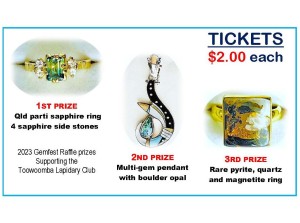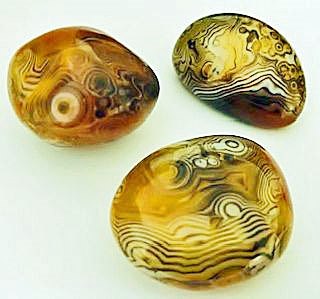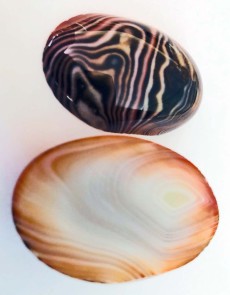2023 GEMFEST Raffle Prize Winners
1st Prize (Ring with faceted stones): Ticket #0322 – T Elliott, Toowoomba
2nd Prize (Pendant): Ticket #0278 – K Aston, Top Camp
3rd Prize (Ring with cabochon stone): Ticket #0581 – L Douglas, Withcott
Congratulations to our three winners and THANK YOU to everyone who bought tickets in the Gemfest Raffle. Your support in this fundraising effort for the Toowoomba Lapidary Club has been very much appreciated.

UPDATE: How to visit the clubhouse
If you would like to visit the clubhouse, please see further information and guidelines on the Contact Us tab. This includes if you would like to become a club member.
Note: Check out the Membership tab for more information on how to join our Club, and fees involved.
Tips on purchasing gemstones
One of the most important occasions when we purchase a gemstone set in jewellery is for an ENGAGEMENT ring. It is quite a considerable outlay of money, and represents a promise of marriage and a symbol of commitment to join in a lifelong relationship.
- How do you know you’re buying a natural gemstone?
- Could the gemstone be man-made, synthetic or simulated?
- Can you tell if the gemstone has been well cut?
- Had you planned on asking anyone for advice before making this extraordinary purchase?
Well, here’s a little bit of help …
Video tutorials on gemstone cutting (by John Dyer)
- How Gem Cutting influences the Value:
https://www.youtube.com/watch?v=1bF3zpFDSkw - How Gems are Cut:
https://www.youtube.com/watch?v=bJPxVwe4Zlw - How to Distinguish between Good and Bad Gemstone Faceting:
https://www.youtube.com/watch?v=eG-vX1OFWXo
Madagascar Banded Agates – buyer beware …


It just might be skin deep! At recent gem and mineral shows in Australia, more traders are selling these agates. They look absolutely fabulous and certainly catch your eye. When I queried one outside trader, suggesting they were ‘not all natural’, I received an emphatic reply – that they had purchased them as natural stones. And anyway, he retorted: How could anyone fake these beautiful colours and the patterns?
You can find these agates are sold under a number of names: ‘Polished Banded Agate crystal’, ‘Madagascar Banded Agate’, ‘Natural Polished Banded Agate’ and ‘Natural Polished Silk Banded Lace Agate’ – to name just a few.
Natural polished? Hmmm. That’s an interesting word combination, when you really think about it!! What actually do these two words placed together, really mean? And especially when you think about the connotation for marketing purposes?
When I searched further, I discovered that some agates found in Madagascar are generally a whitish or greyish colour. Now it’s all starting to make sense. And, if you look hard enough on eBay, you can even find their own description says:
This amazing find comes from the Betsiboka River basin near Vitataly, Madagascar known as the Mad River. It features amazing bands and patterns. While the stone is natural mined material and the banding and patterns are all natural, the material is dyed to create the red coloration in the Agate by soaking in an iron-nitrate mineral solution. The coloration seeps into the banded layers of Agate in different amounts depending on the purity of the crystal in that layer, resulting in the magnificent banded color layers. [Spelling & grammar edits have been made.]
So just to recap, we have natural mined material, with natural banding and patterns, an un-natural treatment, and a natural polish (whatever that means?) … making the buyer (whether they are a wholesaler, retailer or selling to the public at a gem show) believe that this is an ALL NATURAL stone, tumbled polish with a wonderful lustre.